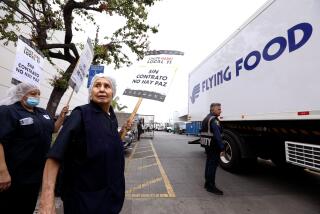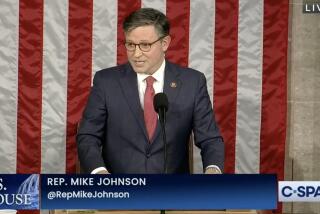Fixes for Retirees’ Safety Net Weighed
WASHINGTON — The nation’s safety net for private pensions, newly saddled with billions of dollars in costs for United Airlines retirees, would face major changes under proposals that Congress is expected to consider in a bid to stabilize the beleaguered system.
Corporate pension plans are bracing for a significant hike in the premiums that they pay to the Pension Benefit Guaranty Corp., a government-sponsored insurer whose latest reported deficit is $23.3 billion. Companies with the shakiest pension financing would face especially steep increases under a plan being pushed by the Bush administration.
United is just the latest in a long line of distressed corporations that have been unable to fully fund their pension plans in recent years -- weighing down the government with costly obligations and raising at least the possibility of a future bailout for the pension insurance agency.
Lawmakers also may decide to change the way companies calculate their long-term pension costs, a matter that could affect the willingness of many healthy companies to continue offering these benefits.
“United Airlines demonstrates the urgency of the situation we face as well as the need for comprehensive pension reform,” said Rep. John A. Boehner (R-Ohio), chairman of the House Committee on Education and the Workforce. “Without reform, more companies will default on their plans or leave the defined benefit pension system entirely.”
He added: “This could ultimately require taxpayer intervention in the future if the financial condition of the PBGC continues to worsen.”
Defined-benefit pensions -- in which retirees get a stable, regular payment that is not affected by investment returns -- have been vanishing by the thousands in recent years. There are an estimated 30,000 such plans, down from 112,000 in the mid-1980s.
In most cases, the discontinued plans were either frozen (no new benefits or participants) or terminated, typically by giving participants a one-time payout or an annuity.
The Pension Benefit Guaranty Corp. steps in when a company, often in bankruptcy proceedings, says there is no way it can pay its existing retirement obligations. This is what United and an increasing number of large companies have done.
As a result, the agency’s deficit -- the amount by which the value of the benefits that it owes retirees exceeds the investments it holds -- has been growing. The nonprofit Center on Federal Financial Institutions, a nonpartisan research group, estimates the agency could go belly up by 2021.
On top of that, government analysts estimate that private pension plans overall are underfunded to the tune of $450 billion.
“The [Bush] administration believes that comprehensive pension reform is critically needed,” Bradley Belt, executive director of the PBGC, testified before a Senate panel last month. “If we do nothing or merely tinker at the margins, the inevitable outcome will be a continued erosion of this important retirement security leg and continued large losses for participants, premium payers and potentially, taxpayers.”
But as Congress moves closer to tackling the long-term problems of the pension system, lawmakers confront a dilemma: The strong medicine that might cure ailing pension plans could also prove distasteful to many companies, which can choose to freeze or terminate their programs.
As a result, the goals of keeping pension sponsors happy and keeping pensions sound are not easily achieved.
“There’s probably no way to completely achieve both objectives,” said Douglas J. Elliott, president of the Center on Federal Financial Institutions. “You’re going to have to make some choices between them.”
In two key areas, Congress faces pressure to act soon. The congressional budget resolution passed in April calls for $6.6 billion in savings from the pension safety program over the next five years.
On Capitol Hill, that is widely viewed as dictating a hike in the premiums that employers pay into the insurance program for their plan participants. The basic premium of $19 per covered employee could rise to $30, as the White House has sought, or possibly even more on a temporary basis.
It is also possible that employers whose plans are on the shakiest footing could face more significant cost increases. Though details have not been worked out, there are increasing expectations that employers will face the first such premium hike since 1991.
“It’s pretty much a done deal,” one Senate Republican aide said, speaking on condition of anonymity because members have yet to vote on the matter.
On the House side, Boehner plans to introduce comprehensive pension legislation within the next several weeks. Premium hikes could be introduced quickly or gradually, said Kevin Smith, a spokesman for the Ohio Republican. “We’re not sure yet,” he said.
In addition, an expiring provision of the law could force a reckoning on the fundamental matter of how companies compute their long-term pension liabilities.
Pension plans use a formula to determine how much money to set aside to meet their obligations. A key variable in the formula is a four-year average of interest rates on long-term corporate bonds.
The Bush administration has proposed replacing that with a 90-day average of rates on long-term bonds. Averaging rates over a shorter time period, backers say, would force companies to keep better pace with changing conditions and not get behind in their obligations.
Because the 90-day average is more volatile, however, companies fear that they could be hit with sharp and unanticipated increases in their pension liabilities.
“Business is going to be fighting tooth and nail” against such proposals, said Don Graves, director of public policy for the Business Roundtable.
Companies are under no obligation to provide pensions, noted James Klein, president of the American Benefits Council, a trade group representing large corporate sponsors of benefit plans.
If Congress imposes changes that are too onerous, he said, companies would not need to enter Bankruptcy Court to eliminate their pension obligations. Instead, they could simply freeze pension plan benefits and membership, or terminate the plans and buy annuities to pay promised benefits.
“What keeps me up at night is the idea that Congress might react to this development in a way that would drive out hundreds, if not thousands of defined-benefit pensions,” Klein said. “The greatest threat to retirement security is not the collapse of a few more poorly funded pension plans. What is truly dangerous is the possibility that thousands of thriving, well-funded plans will be forced out of the system by an overreaction to the PBGC deficit.”
Such a scenario would hurt workers by making them more dependent on their own savings for retirement.
Employees and retirees can also suffer when the pension agency takes over a plan, because the insurer imposes limits on benefit payments.
There’s an annual maximum, which is $45,614 for someone who retires at age 65 and is adjusted for inflation each year. The maximum is less under certain circumstances, including retirement before age 65.
In the case of United, pilots who would normally get a pension exceeding $100,000 a year will be guaranteed only $29,649 from the agency because federal rules force them to retire at age 60. (That guaranteed payment could rise, however, depending on investment returns and other factors.)
Workers with smaller pensions retain a higher proportion of benefits. Retired United mechanics are expected to keep at least 80% of promised benefits, and most retired flight attendants will get 100%. Flight attendants who are still working will see a cut in benefits only if they retire before age 65.
Beyond the costs to employees, worker advocates say there is a ripple effect when employers walk away from their pension obligations.
“If companies can use the bankruptcy process to shed their pension obligations and come out healthy, it creates a precedent,” said Karen Friedman, policy director at the Pension Rights Center in Washington. “Then everything gets justified with, ‘We live in a global economy. If our competitors are doing this, we have to too.’ ”
More to Read
Inside the business of entertainment
The Wide Shot brings you news, analysis and insights on everything from streaming wars to production — and what it all means for the future.
You may occasionally receive promotional content from the Los Angeles Times.










